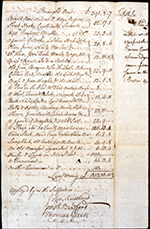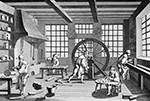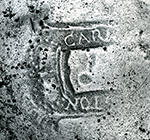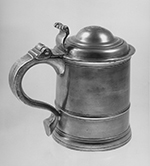Paddy’s Alley

The Paddy’s Alley site was named after the Paddy family who settled there in the mid-1600s. But when archaeologists excavated the site, they found evidence not of the Paddy family, but of John Carnes, a later resident. Carnes was a fine metalsmith who worked mostly with pewter and brass. He lived and worked at Paddy’s Alley from 1729 to 1760. While there, he ran a successful workshop while raising 14 children with his wife. He was a high-ranking military figure and a prominent citizen. At the time of his death in 1760, Carnes was among the wealthiest men in Boston, leaving an estate worth more than £1,800. Today his pewter work is recognized as some of the finest pre-Revolutionary craftsmanship in the country.

Carnes lived in a neighborhood full of merchants, traders, and craftspeople including a shoemaker, a carpenter, a barber and wig maker, and a tailor. When Carnes purchased his houselot, it contained a stone house and four tenements. In the southwest section of the lot, archaeologists found a concentrated area of trash, called a trash midden underneath a brick pavement. The midden contained large amounts of cultural material associated with Carnes’s occupation.
John Carnes: Craftsman and Soldier (1698-1760)
John Carnes was born in Boston in 1698; he was the son of a captain in the British Navy. In 1720, he married Eliza Greenough. Eliza must have died soon after their marriage because 2 years later he married Sarah Baker. Together John and Sarah had 14 children. Sarah died in 1740, and Carnes married Dorothy Farnum. Dorothy never had any children of her own, but she took on the daunting task of raising Sarah and John’s 14 children.

In 1733, Carnes joined the Ancient and Honorable Artillery Company, the oldest chartered military organization in the Western Hemisphere. He initially served as second sergeant, but rose to lieutenant in 1745 and to captain in 1748. He also joined the Boston militia regiment, advancing to the rank of lieutenant colonel by the time of his death.
Carnes fell ill in 1760 and died on March 10th after having been bedridden for several days with a fever. In his will he made provisions for his mother and his wife and divided the rest of his property equally among his children. To settle his vast estate, the land was sold and the proceeds were divided among his heirs. Included among his possessions were a marble table, mahogany furniture, tenement buildings, and two wells with water pumps.
John Carnes’s probate inventory tells us a lot about his work as well. The list of his property taken at the time of his death lists a pewterer’s wheel and 695 lbs. of pewterer’s molds. This is almost twice as many molds as listed for two other Boston pewterers combined. His shop clearly produced a significant number of pewter items including tankards, buckles, and building hardware, and must have been a very busy place.
Archaeology at John Carnes’s Workshop
The 18th century was a prosperous time for Boston’s many artisans and craftsmen. Boston was an ideal location for businessmen because, like many other coastal cities, the city was home to a large population of well-to-do residents able to purchase luxuries as well as the basic necessities. For many years, Bostonians relied on expensive imports from Britain to stock their households. By the 18th century, Boston’s craftspeople were producing items that equaled British imports in quality. Without the expense of shipping items across the Atlantic, moreover, Boston merchants could sell their goods much more cheaply. Public demand for these local products was very high. Residents of the neighborhood could go directly to Carnes’s shop and buy all the plates, tankards, and utensils they needed. Boston boasted some of the finest metalworkers in the colonies and John Carnes’s pewter was among the best.

When archaeological excavations began at Paddy’s Alley in 1992, the project area was an asphalt-surfaced parking lot. Under the asphalt there was a glimpse into an 18th-century metalsmith’s workshop.
Carnes constructed a large building on the site around 1730. Described in 1761 as a warehouse, this building may also have functioned as Carnes’s workshop and sales floor. The building stood in the rear corner of the property and measured about 20 x 20 feet. Archaeologists found portions of foundation walls, a wood-planked interior floor, and an exterior brick pavement adding important details to the documentary history.

Among the artifacts recovered in and around the warehouse were many clues about colonial metalworking. For example, some items had small pewter nodules fused to them, an unavoidable consequence of working with hot metal. In a trash midden archaeologists found crucible fragments, unfinished castings, and metal concretions, all discarded from the workshop. Several recovered “casts” reveal that Carnes worked with many different metals. We can also put together the tool kit of a metalsmith from the numerous fragments of metalworking tools recovered from the foundation of the Carnes warehouse and shop. These include files, soldering tools, and chisels.


Only two examples of Carnes’s work are known. This pewter tankard is on display at the Winterthur Museum in Delaware. The other piece, a plate discovered in a junk shop, was identified by the touch mark on the base, which reads “Carnes Boston.”